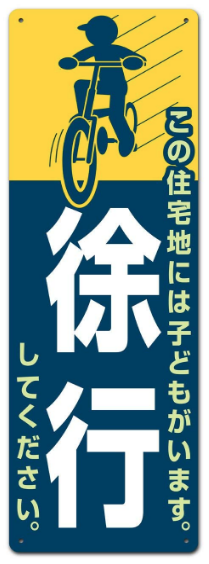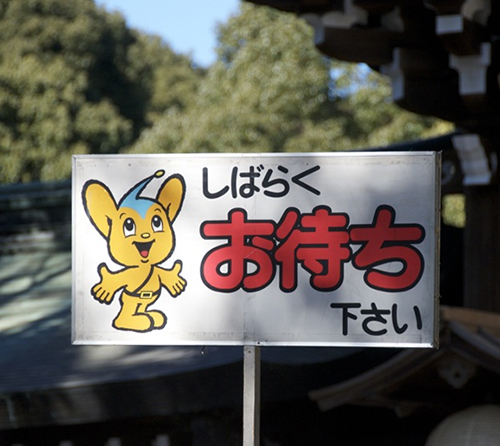60. The "Going Person" Radical: 彳
There's a lot going on with the "going person" radical 彳!
In some ways it's very simple. You can draw it in three easy strokes, and the shape never changes.
One can refer to 彳 in English as the "step" radical or the "stride" radical. My sources primarily call it "going man." But as women go places, too, we'll update that name by calling 彳 the "going person" radical.
In the 19 Joyo kanji that feature this on-duty radical, 彳 always appears on the left side, as in these examples:
往 (623: going)
徳 (762: moral excellence)
復 (782: returning; repeating)
御 (1158: honorific prefix; to control)
徴 (1596: to collect; sign; characteristic)
The radical isn't on the left in some non-Joyo kanji, such as 屐 (clog), 垳 (cliff), and 哘 (to entice), but we needn't worry about those here.
Photo Credit: Eve Kushner
This inscribed stone monument in Kamakura (south of Tokyo) shows us how our radical used to look. I'm talking about the four seal-script characters at the top. They are as follows:
拾 寒
得 山
These are people's names; 寒山 (かんざん or Hanshan) and 拾得 (じっとく or Shide) were poets and priests in ancient China during the Tang dynasty. According to one encyclopedia, Hanshan was called 寒山 because he lived in cold (寒) mountains (山). Shide was called 拾得 because he was an abandoned child until his master picked him up (拾) and "acquired" (得) him. The second name contains our radical in this character:
得 (761: to acquire; gain; profit; attain; be able to)
Henshall says that 彳 wasn't always part of 得 but was added later. You could say that 得 acquired it!
Distinguishing the 彳 Radical from Two Others
The Japanese refer to the 彳 radical as ぎょうにんべん. The ぎょう in that name distinguishes 彳 from the similar-looking亻radical in kanji such as 仙 (1490: mythical being). That variant of the "person" radical 人 (radical 9) is called にんべん. One can render にんべん and ぎょうにんべん in kanji as follows:
人偏 (にんべん: "person" radical) person + left-hand radical
行人偏 (ぎょうにんべん: "going person" radical) going + person + left-hand radical
Now we can see more clearly that にんべん means "'person' radical on the left side of a kanji."
The idea behind the second name seems to be that 彳 is a 亻(にんべん)-like radical used in the 行 kanji (ぎょう). That ぎょう reading is a Joyo on-yomi of 行.
But get this—the 行 kanji isn't considered to have the 彳radical! Instead, the entire 行 shape serves as yet another radical:
行 (radical 144: "going" radical)
Incidentally, in Nelson's kanji dictionary, all characters that have historically been treated as having the 行 radical have instead been placed in the "radical 60" section, with the exception of the 行 kanji itself. Nelson created a "radical 144" section just for that character. By contrast, Joy o' Kanji recognizes six Joyo kanji as having 行 as the on-duty radical.

I was sure that the sign above featured two neatly stacked instances of the 彳radical! How astonishing that we are instead seeing radical 60 (彳: "going person") followed by radical 144 (行: "going"). They are in this word:
徐行 (じょこう: going slowly) slowly + going
Even if 行 doesn't contain our radical, it still means "going," both as a kanji and as a radical, so it's surprising that this word has very little get up and go! The Japanese use this term to tell motorists to go slowly.
Here's what the sign says:
徐行してください。
Please go slowly.
この住宅地には子供がいます。
There are kids in this neighborhood.
住宅地 (じゅうたくち: residential
district); 子供 (こども: child)
Slowpokes
In 徐行, the first kanji means "slowly," so that's what applies the brakes to the word. Here is the character in question:
徐 (1385: slowly; gradually)
The 彳 radical means "road" or "go," says Henshall in his newer edition, whereas the right side of 徐 (excess) acts phonetically to express "gentle, slow." Thus, the whole character means "go slowly."
Now we've zeroed in on 余 as the slowpoke in 徐. Out of all the Joyo kanji with an on-duty "going person" radical, that's the only character with a 余 component, so 徐 should be an anomaly, right? Wrong!
It turns out that 彳 is an autonomous (and non-Joyo) character meaning "linger; loiter; stop"! I can't believe it!
What's more, 彳 joins another non-Joyo kanji in the word 彳亍 (てきちょく), which means “to stand still" and "to go a little and stop.” In this context, 彳 stands for “a step with the left foot,” and 亍 means “a step with the right foot”! As we're so used to seeing these shapes inside the character 行, the spacing in the word 彳亍 looks extremely weird!
The following kanji also have to do with dragging one's feet, so to speak, and Henshall's etymologies reveal why:
後 (111: after; latter; in back; remainder)
The 彳 represents "road" and "movement" but combines here with the 夂 to indicate "abnormal progress." The 幺 lends the meaning "little," so 後 means "to make abnormally little progress," indicating a delay. By extension, 後 means "coming after" or "behind."
待 (337: to wait, anticipate; treat, host)
Our radical means "movement along a road," and the 寺 acts phonetically to express "stop." Together these halves yield "stop moving" and hence "wait."
So there you have it—our "going person" radical brings us to a halt!

Photo Credit: Christopher Acheson
Look how cheerful this cartoon character is while telling us to hold our horses! That's ピーポくん, a mascot of the Tokyo Metropolitan Police Department.
Here's how the sign translates:
しばらくお待ち下さい
Please wait awhile
しばらく (for awhile); 待つ (まつ:
to wait); 下さい (ください: please)
At the center is our "going person" radical in 待 (337: to wait), helping us to go nowhere.
On the Move
In the following two kanji, 彳 means "movement along a road," according to Henshall:
役 (397: role; usefulness; service)
The right side represents "weapon in hand." The whole character originally referred to soldiers who were "going off to fight," then came to mean "service," "duty," and by extension "role."
徒 (554: follower; to go on foot)
The character initially meant "someone who went on foot," especially foot soldiers, as well as "crowds" and "followers." Eventually, "follower" prevailed as the main meaning.
So military action prompted movement in both situations. Is that what it takes to motivate people?
Photo Credit: Eve Kushner
Whereas the sign with the kid on the bike didn't feature two instances of our radical, this can does. Vertically, we have this:
微糖 (びとう: low in sugar)
決定版 (けっていばん: definitive edition; last word)
The first kanji is 微 (1735: slight; micro-). The word 微糖 recurs in the large diagonal writing across the middle, preceded by this term:
挽きたて (ひきたて: freshly ground), where 挽 is non-Joyo
Together these two words tell us that the coffee beans have been freshly ground and that the brewed coffee is low in sugar.
Now you know that 彳 pops up twice in the same word! As for the role of the radical in 微, Henshall says that this character once meant "to make someone move (along a road) in a crouched fashion," indicating "secretively." Nowadays, people usually use 微 with its associated meanings, "obscure, faint, tiny."
Across the bottom we find these kanji terms:
奥深い (おくぶかい: deep)
豆感 (まめかん: the sense of fresh beans), a word coined for this product
香りくっきり (かおりくっきり: distinct flavor; pleasantly strong flavor)
甘さ、すっきり, which is the same as 甘さすっきり (あまさすっきり: just enough sweetness)
Thus, there’s a deep sense of fresh coffee beans, a distinct flavor, and just enough sweetness.
The Meanings of 彳
Although 彳 is called "going person," we've seen that it instead tends to mean "movement," "road," or "movement along a road." That continues to be true in nearly all other Joyo kanji in which this radical is on duty. Here are a few more examples, again with etymologies from Henshall:
径 (845: path; diameter)
The radical means "road." The right side phonetically expresses "small" and "direct." A "small, direct road" leads to both "path" and "direct." (I haven't defined 径 as "direct," but the "path" part matches.)
従 (891: to follow; accompany; engage in (business); therefore; secondary)
The radical means "road" and "move." To put it simply, 従 depicts "two people moving along a road, with one following the other."
彼 (1725: he; boyfriend; that)
The 彳represents "movement (along a road)." The 皮 (skin) acts phonetically here to express "distance" and probably also "part" (because 皮 depicts "parting the skin from the flesh" of an animal, which is to say "pulling off its hide"). The whole character means "to move into the distance (thus parting?)," which refers to "heading for a distant destination/goal." The character also came to mean "yonder" and therefore "that (over there)." Its use as a third-person pronoun results from the associated idea of "that person," says Henshall. Who knew?!
Movement with 彳 has been literal thus far, so I'm intrigued to find figurative usage in just one Joyo kanji, at least as Henshall has it:
律 (993: law; principle; rhythm)
The radical means "path," figuratively speaking. The right side represents "brush in hand," indicating "writing" and by extension "prescribing." Furthermore, that right-hand phonetic lends its sound to express "one." Thus, 律 symbolizes "the one (and only) prescribed path (to follow)," which is to say "the law"!
